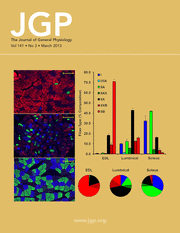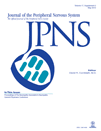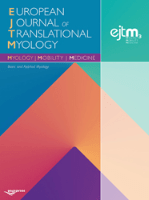
MUSCLE & NERVE
Scope & Guideline
Pioneering Insights in Muscle and Nerve Dynamics
Introduction
Aims and Scopes
- Neuromuscular Disorders:
The journal extensively covers various neuromuscular diseases including amyotrophic lateral sclerosis (ALS), myasthenia gravis, muscular dystrophies, and inflammatory myopathies. This focus allows for a comprehensive understanding of the pathophysiology, diagnosis, and management of these conditions. - Electrophysiology:
There is a strong emphasis on electrophysiological studies, including nerve conduction studies, electromyography, and innovative techniques to assess neuromuscular function. These methodologies are crucial for diagnosing and monitoring neuromuscular disorders. - Muscle Imaging and Ultrasound:
The use of advanced imaging techniques, particularly ultrasound, is a recurring theme. Studies often explore the utility of muscle ultrasound in diagnosing conditions, assessing disease progression, and guiding therapeutic interventions. - Therapeutic Interventions:
The journal publishes research on various therapeutic approaches, including pharmacological treatments, gene therapies, and rehabilitation strategies for neuromuscular diseases, highlighting their efficacy and safety. - Patient-Centered Outcomes:
Research often includes patient-reported outcomes, quality of life assessments, and the psychosocial impact of neuromuscular disorders, which are essential for understanding the holistic impact of these diseases on patients. - Emerging Technologies:
There is a growing interest in the application of novel technologies such as artificial intelligence, machine learning, and telemedicine in the diagnosis and management of neuromuscular disorders.
Trending and Emerging
- Gene Therapy and Genetic Research:
There is a significant increase in studies focusing on gene therapy, particularly for conditions like spinal muscular atrophy and Duchenne muscular dystrophy. This reflects the growing interest and advancements in genetic interventions as potential curative approaches. - Telemedicine and Remote Monitoring:
The COVID-19 pandemic has accelerated the adoption of telemedicine and remote monitoring technologies in neuromuscular care. Publications increasingly explore the efficacy and patient acceptance of these approaches. - Artificial Intelligence and Machine Learning:
Emerging research is integrating artificial intelligence and machine learning techniques to enhance diagnostic accuracy and predict disease progression in neuromuscular disorders, indicating a trend towards more data-driven approaches. - Focus on Quality of Life and Patient-Centered Research:
There is a growing emphasis on studies that assess the quality of life, psychosocial aspects, and patient-centered outcomes in neuromuscular disease management, highlighting the importance of holistic care. - Multidisciplinary Approaches to Care:
Research increasingly advocates for multidisciplinary care models that incorporate various health professionals to optimize treatment outcomes for patients with complex neuromuscular disorders.
Declining or Waning
- Traditional Electrophysiological Techniques:
Although still important, there seems to be a shift away from solely relying on traditional nerve conduction studies and electromyography as standalone diagnostic tools, as newer methodologies and imaging techniques gain traction. - Invasive Procedures:
There is a noticeable decline in studies focusing on invasive procedures such as nerve biopsies, likely due to advances in non-invasive imaging techniques that yield comparable diagnostic insights. - Generalized Studies on Neuromuscular Disorders:
There appears to be a trend away from broad, generalized studies of neuromuscular disorders towards more focused, condition-specific research, particularly those that address specific genetic or molecular mechanisms.
Similar Journals

Therapeutic Advances in Neurological Disorders
Pioneering insights for the treatment of neurological disorders.Therapeutic Advances in Neurological Disorders, published by SAGE Publications Ltd, is a leading open access journal dedicated to the advancement of knowledge in the field of neurology. Since its inception in 2008, this journal has established itself as a vital resource for researchers, healthcare professionals, and students, offering a platform for the dissemination of high-quality research that improves the understanding and treatment of neurological disorders. With a commendable impact factor and ranked Q1 in multiple categories, including Neurology and Pharmacology for 2023, it exemplifies excellence in scholarly contributions. The journal's Scope encompasses a wide array of topics, providing insights that are pivotal for clinical practice and pharmacological development. Additionally, with its commitment to open access since 2017, Therapeutic Advances in Neurological Disorders ensures that its research reaches a global audience, fostering collaboration and innovation in neurological science.

JOURNAL OF GENERAL PHYSIOLOGY
Pioneering Insights in Physiology Since 1918JOURNAL OF GENERAL PHYSIOLOGY, published by Rockefeller University Press, is a leading peer-reviewed journal that has been at the forefront of physiological research since its inception in 1918. With an ISSN of 0022-1295 and an E-ISSN of 1540-7748, this esteemed journal maintains an impressive Q1 ranking in the field of Physiology, reflecting its high-quality contributions to both the basic and applied aspects of physiology. Regularly cited in the scientific community, it ranks 70th out of 193 in the category of Biochemistry, Genetics, and Molecular Biology, showcasing its significant impact within academic circles. The journal publishes original research, reviews, and commentaries, aiming to advance the understanding of physiological mechanisms and their implications across various biological systems. Although not Open Access, the journal remains a vital resource for researchers, professionals, and students dedicated to exploring the depths of cardiopulmonary function, neurophysiology, and cellular biochemical processes. The JOURNAL OF GENERAL PHYSIOLOGY continues to serve as a critical platform for disseminating innovative findings and fostering collaboration among scientists globally.

AUTONOMIC NEUROSCIENCE-BASIC & CLINICAL
Empowering Knowledge in Neuroscience and MedicineAUTONOMIC NEUROSCIENCE-BASIC & CLINICAL, published by Elsevier, stands as a pivotal journal in the fields of Cellular and Molecular Neuroscience, Endocrine and Autonomic Systems, and Neurology (Clinical), boasting an impressive Q2 ranking in the latter two categories as of 2023. This journal, which has been in circulation since 2000, provides a vital platform for disseminating innovative research pertaining to the autonomic nervous system's fundamental and clinical aspects, thus addressing significant challenges in both theoretical understanding and clinical application. Researchers and practitioners worldwide find value in its comprehensive articles, reviews, and case studies that explore the intricacies of autonomic neurobiology. As part of Elsevier's prestigious portfolio, the journal offers options for Open Access, enhancing the visibility and accessibility of its content. With an increasing impact on clinical practices and research directions, AUTONOMIC NEUROSCIENCE-BASIC & CLINICAL serves as an essential resource for advancing knowledge and fostering collaboration among scholars, clinicians, and students dedicated to unraveling the complexities of the autonomic nervous system.

CURRENT OPINION IN NEUROLOGY
Illuminating Trends in Neurology and Beyond.CURRENT OPINION IN NEUROLOGY is a premier academic journal dedicated to providing insightful overviews and critical analyses across all areas of neurology and clinical neurology. Published by Lippincott Williams & Wilkins, this esteemed journal boasts an impressive impact factor, highlighting its influence and relevance in the field—positioning it in the Q1 category for both neurology and clinical neurology as of 2023. With its comprehensive coverage, the journal serves as a vital resource for researchers, healthcare professionals, and students aiming to stay abreast of the latest developments, trends, and breakthroughs in neurological science and practice. Though not open access, articles are available via institutional subscriptions or individual purchase, ensuring that vital research remains accessible to a wide audience. Covering research from its inception in 1993 to ongoing studies in 2024, CURRENT OPINION IN NEUROLOGY stands out as an essential platform for disseminating knowledge and fostering dialogue within the dynamic and evolving landscape of neurology.

JOURNAL OF VASCULAR RESEARCH
Innovating research in vascular health.Welcome to the JOURNAL OF VASCULAR RESEARCH, a reputable academic journal published by KARGER that has been a cornerstone of vascular research since 1964. With an ISSN of 1018-1172 and an E-ISSN of 1423-0135, this journal plays a vital role in disseminating cutting-edge research in the fields of Cardiology and Cardiovascular Medicine and Physiology. Currently categorized in the Q3 quartile for both disciplines, it ranks as #179 in Cardiology and #131 in Physiology according to Scopus, showcasing its significant contribution to the scientific community. Although the journal operates on a subscription basis, it strives to provide accessible content that informs and inspires researchers, professionals, and students alike. As the journal looks forward to its convergence in 2024, it continues to uphold its mission of advancing knowledge, fostering innovation, and encouraging collaboration within the dynamic realm of vascular research.

JOURNAL OF THE PERIPHERAL NERVOUS SYSTEM
Fostering Dialogue in Cutting-Edge NeuroscienceJOURNAL OF THE PERIPHERAL NERVOUS SYSTEM, published by Wiley, is a prestigious peer-reviewed journal dedicated to advancing the understanding of the peripheral nervous system. With an ISSN of 1085-9489 and E-ISSN of 1529-8027, this journal has been a vital resource for researchers and clinicians since its inception in 1996 and continues to publish cutting-edge research through to 2024. Ranked in the second quartile (Q2) in both Medicine (miscellaneous) and Neurology (clinical), and holding a commendable position in the third quartile (Q3) for Neuroscience (miscellaneous), it reflects a strong impact factor within its fields, including a 72nd percentile rank in clinical neurology. The journal focuses on providing a platform for innovative research findings, reviews, and clinical studies that broaden the understanding of peripheral nerve pathophysiology and therapies. Researchers, students, and professionals in neuroscience and related disciplines will find the journal's diverse range of articles invaluable for keeping abreast of the latest developments and fostering scientific dialogue.

MEDICINE & SCIENCE IN SPORTS & EXERCISE
Empowering practitioners with the latest in sports science.MEDICINE & SCIENCE IN SPORTS & EXERCISE is a premier journal published by Lippincott Williams & Wilkins, dedicated to advancing the fields of sports medicine, exercise physiology, orthopedics, and physical therapy. With a significant history dating back to 1969, this journal provides a critical platform for disseminating cutting-edge research and clinical insights that shape contemporary sports science. Recognized for its rigorous peer-review standards, it boasts an impressive impact factor and ranks in the top quartile (Q1) across pivotal categories including Orthopedics and Sports Medicine, Physical Therapy, and Rehabilitation. Researchers and healthcare professionals will find it an invaluable resource for the latest findings and trends that inform practice and enhance athletic performance. The journal is available in both print and digital formats, ensuring accessibility for its audience worldwide. By fostering a rich dialogue among scientists, practitioners, and students, MEDICINE & SCIENCE IN SPORTS & EXERCISE solidifies its importance in the evolving landscape of sports health and exercise research.

Journal of Cachexia Sarcopenia and Muscle
Exploring innovative solutions for muscle disorders.The Journal of Cachexia Sarcopenia and Muscle is a premier open-access publication dedicated to advancing the understanding of muscle wasting, cachexia, and related disorders. Published by Wiley, this esteemed journal boasts an impressive impact within its fields, achieving a Q1 classification in both Orthopedics and Sports Medicine, and Physiology (Medical) for 2023. With a Scopus ranking of #4 out of 321 in Orthopedics and Sports Medicine, and #10 out of 113 in Physiology, it firmly positions itself at the forefront of medical research. The journal’s scope includes comprehensive studies, reviews, and innovative clinical trials that contribute to the scientific community’s understanding of muscle health and performance. Since its inception in 2010 as an open-access platform, the Journal of Cachexia Sarcopenia and Muscle has facilitated a growing dialogue among researchers, healthcare professionals, and students, emphasizing its crucial role in tackling the multifaceted challenges posed by muscle diseases. For those invested in the latest research trends and clinical advancements, this journal stands out as a vital resource and reference point.

European Journal of Translational Myology
Advancing Myological Research for Clinical ImpactEuropean Journal of Translational Myology is a premier, open access journal published by PAGEPRESS PUBL, dedicated to advancing research in the dynamic field of myology and its applications in various medical disciplines. Established in 2010, this journal disseminates crucial findings pertinent to translational myology, covering aspects within Cell Biology, Molecular Biology, Neurology, and Orthopedics and Sports Medicine. With a notable presence in the Scopus rankings and respectable quartiles across various categories, including Q3 positions in key areas as of 2023, the journal offers an invaluable platform for researchers and clinicians aiming to bridge the gap between experimental research and clinical practice. Located in Pavia, Italy, the journal welcomes contributions from scholars worldwide, fostering a collaborative environment that enhances knowledge exchange and encourages innovative approaches in myological research.

Journal of Brachial Plexus and Peripheral Nerve Injury
Advancing knowledge in nerve injury management.The Journal of Brachial Plexus and Peripheral Nerve Injury, published by THIEME MEDICAL PUBL INC, is a leading open-access journal dedicated to the field of neurology, specifically focusing on injuries related to the brachial plexus and peripheral nerves. Since its inception in 2006, the journal has provided a platform for researchers, clinicians, and students to share cutting-edge studies and advancements within this specialized area of neurology. With an impact factor that underscores its relevance in the academic community, the journal is categorized in the Q4 quartile for both Neurology and Clinical Neurology in 2023. The journal aims to foster collaboration and innovation among professionals by presenting rigorous research findings, clinical studies, and reviews that enhance the understanding and management of nerve injuries. Published from the United Kingdom, the journal facilitates global access to important knowledge, encouraging contributions that will further the discourse in this critical field of medicine.